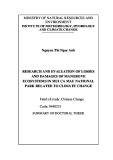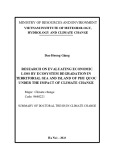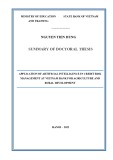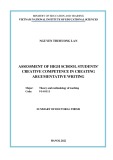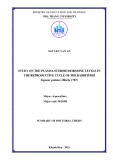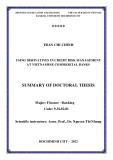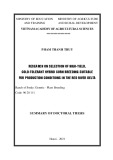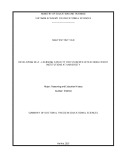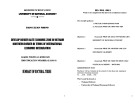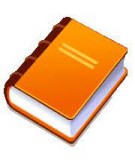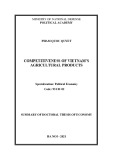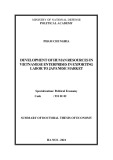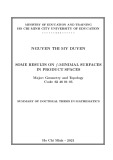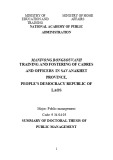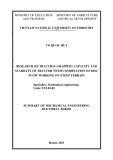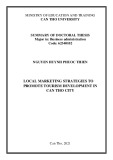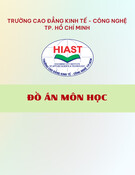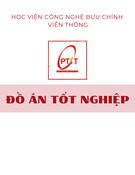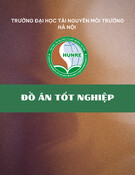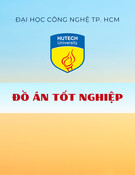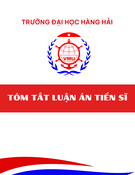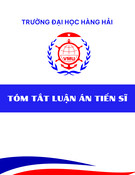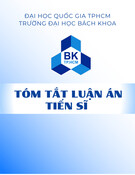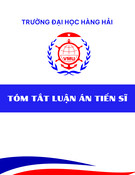MINISTRY OF EDUCATION AND TRAINING
HANOI UNIVERSITY OF MINING AND GEOLOGY
NGUYEN VAN CUONG
RESEARCHING CHANGE OF SOUND VELOCITY AND COMPLETE SAMPLING PROCESS
TO DETERMINE SOUND VELOCITY IN THE SEAWATER OF TONKIN GULF IN VIETNAM
FOR EXPLOIT EFFECTIVELY OF HYDROACOUSTICS EQUIPMENT
Major : Surveying and Mapping Engineering
Code : 9520503
SUMMARY OF DOCTORAL THESIS
Hanoi - 2021
The thesis is completed at: Geodesy department
Faculty of Geomatics and Land Administration
Hanoi University of Mining and Geology
Supervisor: Assoc. Prof. Dang Nam Chinh, PhD
Reviewer 1: Prof. Hoang Ngoc Ha, Sc.D.
Reviewer 2: Bui Dang Quang, PhD
Reviewer 3: Assoc. Prof. Tran Viet Tuan, PhD.
The thesis will be examined by Examination Board in Hanoi University of Mining and
Geology at of date month 2021
The thesis can be found in the libraries:
- National library, Vietnam
- Library of Hanoi University of Mining and Geology
1
INTRODUCTION
1. The necessity of the thesis
Vietnam is a rich water country with coastline stretching from Mong Cai to Ha Tien,
totaling about 3,260 km of coastline west of the South China Sea [37]. Along the coast
every 23 km there is an estuary, the establishment of large-scale hydro-maps, seabed
topography and underwater construction processes with high-precision hydro-equipment
should be focused. During the construction process with hydro-devices there are many
factors that affect the accuracy of measurement results, so, it is necessary to calculate
correction to limit the influence of factors. The sources of errors as mentioned above include
the influence of GNSS positioning equipment, motion correction equipment, installation of
measuring devices, determination of sound velocity in water environments, etc.
Accurate determination of the velocity of sound spread in the water environment at
the measuring area and at the time of measurement is very important because the sound
velocity determination error affects the results of deep measurements increasing as the depth
increases. To do this, we need to study and analyze the sound velocity transformation
characteristics in the characteristic areas, then propose and propose a method to determine
the right sound velocity for each region.
The problem of sound velocity in seawater environments is studied through the
observation of representative parameters such as temperature, depth (pressure), salinity. The
studies that have been conducted are extensive, not yet reflecting the detailed variations of
sound velocity.
With the aim of going into studying sound velocity in seawater, the author wants to
study the analysis of the rules, and the effects of sound velocity in typical waters of
Vietnam, namely the Gulf of Tonkin region. Analysis assesses the effect of sound velocity
by depth, region, over time to show the sound velocity variations according to each
influential factor. From the experimental data, the results of the analysis, the author
conducted a study to build a sound velocity database, giving the law of sound velocity
change in seawater in the Gulf of Tonkin region.
For these reasons, chosing the thesis topic: “Researching change of sound velocity
and complete sampling process to determine sound velocity in the seawater of Tonkin
Gulf in Vietnam for exploit effectively of hydroacoustics equipment” has significant
meaning in term of science and reality.
2. The aim and content of research
2
Establishing scientific basis and method of analyzing the law of sound velocity
change in seawater in the Gulf of Tonkin region of Vietnam to complete the process of
sampling sound velocity to effectively exploit hydroacoustics equipment.
3. The subjects and scope of research
- Research subjects:
Databases of temperature, salinity, sound velocity of the Gulf of Tonkin region by
the time and the space.
- Research scope:
The change in temperature, salinity and depth factors in the Gulf of Tonkin region is
intended to assess the impact of these factors on sound velocity.
Effects of sound velocity changes on common hydroacoustics equipment.
4. Literature review
Collecting data on temperature, salinity, sound velocity, cross section already in the
The study analyzed sound velocity characteristics distributed by region, by depth and
Based on current regulations, the sound velocity change thereby proposes a sampling
study area is the waters of the Gulf of Tonkin. Analysis of data sources obtained, additional proposals in some areas with sound velocity data defects. over time in the Gulf of Tonkin. Theoretical basis study determines sound velocity by depth, sound velocity represented by region and assesses the effect of sound velocity determination errors on measurement results by hydroacoustics equipment. process that determines sound velocity in the Gulf of Tonkin region. 5. Theoretical points
The first point: The Gulf of Tonkin is a small depth, with many estuaries so temperature and salinity variations are factors in the law of sound velocity change by space
and time. That characteristic has affected sound velocity variations in the water environment over the months of a year up to 27.2 m/s.
The second point: The sound velocity sampling process proposed in theory is based
on the results of analysis of temperature changes, salinity of the Gulf of Tonkin, current
sound velocity sampling process reviews, analysis of advantages and disadvantages of the
process. From the law of sound velocity transformation, the disadvantages of the current
sound velocity sampling process proposes a new sound velocity sampling process for
effective extraction of hydroacoustics equipment.
The third point: The proposed sound velocity sampling process, along with a sound
velocity database in the Gulf of Tonkin region, have built up to meet the accuracy
3
requirements when applying hydroacoustics equipment in the establishment of a 1:10.000
and smaller seabed topography in the Gulf of Tonkin region.
6. The new points of the thesis
Sound velocity in the Gulf of Tonkin region has complex laws of change. The thesis
gave an analysis and visual assessment of the change in sound velocity in the Gulf of
Tonkin by location, space and time in order to effectively exploit the hydroacoustics
equipment.
Using the World Oceanic Database (WOD) and oceanic database of the Russian Far East Ocean unit to build a sound velocity database for the Gulf of Tonkin region. The
accuracy of this database is evaluated based on actual measurement results.
The sound velocity database was built as a result of the new application in the survey
to establish a 1:10.000 and small seabed topography map in the Gulf of Tonkin region.
7. The scientific significance
Develop a sound velocity distribution database in seawater in the Gulf of Tonkin region, develop a sound velocity database mining program, calculate sound velocity values at required locations based on the built-in database. 8. The practical significance
Exploiting and using sound velocity databases for survey cases, map ratios in the
The thesis consists of 4 chapters without introduction and conclusion: - Introduction - Chapter 1. Overview of sound velocity and application of hydroacoustics
Gulf of Tonkin region. 9. Content of the thesis equipment in seawater. - Chapter 2. Studying the law of sound velocity change, methods of determining
sound velocity in seawater - Chapter 3. The effect of sound velocity on the accuracy of hydroacoustics
equipment, the velocity change in the gulf of tonkin
- Chapter 4. Build a sound velocity database and complete the sound velocity
sampling process in the Gulf of Tonkin and experiment.
- Conclusion and proposal
4
10. Place of research
The thesis has been completed at Geodesy department, Faculty of Geomatics and
Land Administration, Hanoi University of Mining and Geology.
11. Acknowledgements
I would like to thanks to Assoc. Prof. PhD. Dang Nam Chinh, teachers and lecturers
from Department of Geodesy, Faculty of Geomatics and Land Administration, Hanoi
University of Mining and Geology for friendly help, support and useful comments. It plays
an important role for me to complete the thesis successfully. I also would like to thanks to leaders of SEAMAP, scientist who spent their
considerations, comments to my thesis. It helps me to complete the thesis a lot.
Finally, I would like to say special thanks to all of the people in my family who spent
the best mental and physical condition for me to spend most of my time on the research
work.
CHAPTER 1. OVERVIEW OF SOUND VELOCITY AND APPLICATION OF
HYDROACOUSTICS EQUIPMENT IN SEAWATER
1.1 Research in the world on sound velocity and sound velocity variations in seawater
5
1.1.1. History of hydroacoustics equipment,application development
As early as the YEARS BC, the Greek philosopher Aristotle (384-322), had the
comment that the sound spreading in the country better than spreading in the air. There were
also studies of the spread of sound in the country, such as those of Leonardo Da Vici (1452–
1519) and Francis Bacon (1561–1626). By the 18th and early 19th centuries, there were
some scientists such as J.A. Nollet (1700-1770), Alexander Monro (1733-1817) who
actually studied, conducted rigorous testing of domestic sound velocity for application for a
number of different purposes.
Currently, the survey (especially in shallow waters - under 50 m and inside) is
increasingly carried out by deep measurement technology by Airborne Lidar Bathymetry -
ALB. The outstanding advantage of LIDAR technology is for fast and high-precision
measurement thanks to the use of modern laser technology. Another advantage of ALB
technology is that in addition to the depth, it also measures the altitude of coastal land,
In 1960, Wayne D Wilson introduced the experimental formula for sound velocity,
In 1974, VA Del Grosso introduced in "New equation for the speed of sound in
In 1975, Medwin came up with a formula for ingesting sound velocity values in
In 1977, Chen and Millero introduced the formula for calculating sound velocity
In 1981, Mackenzie introduced the formula for calculating sound velocity in his
allowing for continuous data blocks of altitude (on land) - depth (under the sea). 1.1.2. Foreign research on sound velocity and sound velocity variations and in 1990 he published the paper "Equation for the speed of sound in Sea Water" [35]. natural waters (with comparisons to other equations)" [22]. "Fundamentals of Acoustical Oceanography" [23]. values in their article "Speed of sound in seawater at high pressures". article "Nine-term equation for the sound speed in the oceans".
The Journal of the Acoustical Society of America, which began in 1929, has made many contributions to the field of sound velocity research in seawater. The authors studied
many aspects of the sound velocity effect on survey results such as energy decline in
shallow, deep water conditions. The sound velocity changes over time, according to the
geographical location affecting the survey results by hydro-equipment, but details for the
Sea of Vietnam have not been studied.
This was followed by Applied Underwater Acoustics books published in 2017 by
authors Thomas H. Neighbors III and David Bradley.
Foreign studies on sound velocity are quite detailed and complete in all aspects, both
applied in hydro-technology. The effect of sound velocity on the survey results when using
6
hydro-devices is also evaluated and results with each region separately. But the sound
velocity change in the Gulf of Tonkin region has not been studied, there is only research in
the South China Sea in water areas with great depths or an overview of the Sea of Vietnam.
1.2. Research works in Vietnam on sound velocity and sound velocity variations in
seawater.
Marine research in Vietnam has been conducted for a long time, according to the
article on marine research [36], since 1920 there have been French research vessels starting
to study the Sea of Vietnam. By the early 1990s, Vietnam began researching and implementing seabed survey
technology. From 1988 to 1995 Naval Command established depth maps in small
proportions such as a scales of 1:1.000.000, 1:500.000, 1:200.000, 1:100.000 coastal areas.
Since 1999, the Ministry of Natural Resources and Environment has implemented
terrain maps with a scale of 1:50.000 and 1:10.000 for state management. In order to ensure
In addition to the documents of state management, there have been other documents
Marine physics by Rof. Dr. Dinh Van Uu - Assoc. Prof. Dr. Nguyen Minh Huan [3]. The ocean sound facility is Translation by Assoc. Prof. Dr Pham Van Huan was
the measurement, the Department of Survey and Mapping Vietnam, now the Department of Survey, Mapping and Geographic Infomation Vietnam, has introduced regulations and regulations for surveying seabed to terrain. that have also studied marine physics such as: published at The National University of Hanoi in 2003. In 2006, at SEAMAP, there was a ministry-level scientific research topic: "Application of sound velocity meters in the measurement of seabed to topsities" by Duong Quoc Luong [5]. In 2011, the Vietnam Academy of Science and Technology published a book on
Vietnam's islands with the title "Marine sounds and sound wave fields in the East Sea of Vietnam" by Pham Van Thuc [6].
1.2.1. Research on the application of hydro-sound equipment in Vietnam
Hydro-sound equipment in Vietnam has been applied by many training
establishments and research and application establishments. In particular, the most used is
single beam technology, often used in the survey of estuary creeks, sea estuaries.
About thesis study of hydro-equipment at the University of Mining - Geology has
research topics on hydro-equipment.
SEAMAP has conducted studies on the application of hydro-devices such as single
beam, multi-beam, side scan sonar, etc.
7
1.2.2. Sound velocity studies in Vietnam published in specialized journals
In addition to the research works of topics or reference books, sound velocity
research is also published in specialized journals or specialized scientific reports.
1.2.3. Studies of sound velocity variations in the Gulf of Tonkin
Separate sound velocity studies in the Gulf of Tonkin currently do not have detailed
and specific research.
8
CHAPTER 2. STUDYING THE LAW OF SOUND VELOCITY CHANGE,
METHODS OF DETERMINING SOUND VELOCITY IN SEAWATER
2.1. Overview of hydrobiology
Each different sound frequency carries a different form of energy and transmits it to a
different depth. Depending on the region, the purpose of the study and survey will be to use
different sound frequencies to suit the requirements. Here are some basic features of sound
waves in seawater
2.1.1. Sound source, energy and unit of measurement 2.1.2. Sound frequency and band width
2.1.3. Sound spread and physical effects of sound waves
2.1.4. Absorption, scattering and sound weakness
2.2. Sound wave sound velocity and factors affecting sound wave sound velocity in
seawater
2.2.1. Sound velocity in seawater 2.2.2. Factors affecting sound velocity in seawater 2.2.3. Experimental formula for determining sound velocity in seawater
In 1960, Wayne D Wilson introduced the experimental formula for sound velocity, and in
In 1974, VA Del Grosso introduced in "New equation for the speed of sound in
In 1975, Medwin came up with a formula for ingesting sound velocity values in
In 1977, Chen and Millero introduced the formula for calculating sound velocity
1990 he published the paper "Equation for the speed of sound in Sea Water" [35]. natural waters (with comparisons to other equations)" [22]. "Fundamentals of Acoustical Oceanography" [23]. values in their article "Speed of sound in seawater at high pressures". In 1981, Mackenzie introduced the formula for calculating sound velocity in his
article "Nine-term equation for the sound speed in the oceans". 2.3. Methods for determining sound velocity in seawater
2.3.1. Using intermediate measurements and applying experimental formulas to determine
the sound velocity and errors that determine sound velocity in seawater
2.3.2. Sound Sound velocity Meter
2.3.3 Barcheck sound velocity measurement
2.4. Sound velocity changes in seawater
2.4.1. Change of sound velocity by salinity
2.4.2 Change of sound velocity according to temperature
2.4.3. Change of sound velocity by depth
9
CHAPTER 3. THE EFFECT OF SOUND VELOCITY ON THE ACCURACY OF
HYDROACOUSTICS EQUIPMENT, THE VELOCITY CHANGE IN THE GULF
OF TONKIN
3.1. Effect of sound velocity on hydroacoustics equipment
3.1.1. Single-beam depth measurement
3.1.2. Multi-beam depth measurement and side scan sonar
3.1.3. Hydro-positioning
3.2. Sound velocity sampling process in survey by hydroacoustics equipment 3.2.1. Single-beam depth measurement process
3.2.2. Multi-beam depth measurement process
3.2.3. Side scan sonar measurement process
3.2.4. Hydro-positioning process
3.3. Requirements for Hydro-Survey Accuracy
3.3.1. IHO Accuracy Standards 3.3.2. Standards for dept measurement accuracy of some countries (Canada, New Zealand, Australia) 3.3.3. Technical regulations on the use of deep meters in Vietnam 3.4 Sound velocity variations in the Gulf of Tonkin 3.4.1. General overview of marine geographical and natural characteristics in the Gulf of Tonkin 3.4.2 Sound velocity data in the Gulf of Tonkin 3.4.3. Sound velocity change by position 3.4.4. Sound velocity variations by Water colum and over time
10
CHAPTER 4. BUILD A SOUND VELOCITY DATABASE AND COMPLETE THE SOUND
VELOCITY SAMPLING PROCESS IN THE GULF OF TONKIN AND EXPERIMENT
4.1. Sound velocity database, data quality assessment
Sound velocity experimental data collected by SEAMAP from years of external
construction along with specialized databases.
The monitoring data set is used for 12 months, observed with a cycle once a month.
Include alues of sound velocity and temperature, salinity, depth. The location of the
observation points is described as Figure 4.1. The map background is provided by google
map [39].
4.2. Building a sound velocity database in the Gulf of Tonkin
4.2.1. Building a sound velocity database
The data is calculated based on a database published according to NOAA's Oceanic
And Oceanic Database and GDEMV 3.0, Russia's Far East oceanic database.
Thesis has built a program to exploit Sound velocity Database, which is programmed in Visual Basic language, easy-to-use and exploitable Vietnamese interface. Sound velocity data mining program interface as pictured.
The data formats of the program are prescribed as follows:
No Tab B Tab L Tab D Tab V
The sound velocity database is built on the following principle: Step 1: Identify data components Step 2: Define tables and columns for the database Step 3: Define the primary key, foreign key, and relationship between objects Step 4: Standardize the database 4.2.2 Use of sound velocity databases
After building the database we choose the method of building mesh points in the
11
database with each mesh with a size of 0.25ox0.25o and selected according to the formula as follows:
Proceed to compare the coordinates of the point to be internally sound velocity with
the points already available to select 4 points.
After selecting 4 mesh points, conduct sound velocity ins depleting by linear
interpolation method according to the function as follows:
VTAi = a0 + a1Bi + a2Li
In which:
a0, a1, a2 are parameters defined according to the principle of the smallest number
of comments based on the sound velocity of the last 4 mesh points.
Bi,Li is the geographical coordinate of the point to extract. With 4 points already available, build the corrected numerical equations in the form
of a matrix as follows:
V = AX + L
With:
a
0
2
V =
A =
L =
1
3
3
X = a a
2
4
VTA 1 VTA VTA VTA
1 v 2 v v v
4
L 1 L 2 L 3 L 4
4
1 B 1 1 B 2 1 B 3 1 B
Extract the sound velocity value on the database using the mining program above, the sound velocity values are extracted according to the single point or according to the metric file many points as shown below:
4.2.3. Comparison of sound velocity on the basis of the actual database and sound velocity
12
To assess the accuracy of the sound velocity database, Thesis used actual
construction sound velocity data over the years of SEAMAP that had duplication
measurement conditions at some locations and had actual sound velocity values and
extracted on the database.
Sound
Actual Sound
Velocity in
Error
No
B (o)
L (o)
Time
velocity
database
(m/s)
(m/s)
(m/s)
1
20.75
107.5
Junly
1540.2
1542.4
-2.2
2
21
108
April
1523.5
1522.2
1.3
3
21
108
May
1528
1527.1
0.9
18
18
107
March
1524.3
1527.3
-3
Difference between real sound velocity and sound velocity on a database
Depth by
Depth by
database
Actual
No
B (o)
L (o)
Time
sound
sound
velocity (m)
velocity (m)
Error
(m/s)
1
20.75
107.5
Junly
13.61
13.63
-0.02
2
21
108
April
22.93
22.91
0.02
3
21
108
May
27.24
27.23
0.02
18
18
107
March
17.37
17.40
-0.03
The difference between the depth using the actual sound velocity and the database
Compare and evaluate the reliability of database sound velocity metrics and actual
sound velocity metrics for a 1:10.000 map scale.
H KT
H KT
H DS (m)
Error
(m)
(m)
Error
No
database
H DS (m) Actual
DH
(m)
database
Actual
(m (m)
(1529.2)
(1531.8)
(1529.2)
(1531.8)
-17.84
-17.88
-0.03
-17.69
-17.72
0.03
-0.16
1
-17.85
-17.88
-0.03
-17.71
-17.74
0.03
-0.14
2
-17.81
-17.84
-0.03
-17.69
-17.72
0.03
-0.13
3
.....
.....
.....
.....
.....
.....
.....
.....
17391
-17.53
-17.56
-0.03
-17.32
-17.35
0.03
-0.21
13
Assess the accuracy of the sound velocity converted by database and by practice
mH=
based on the formula:
At this time mH= 0.03 m; meanwhile the limit difference of the depth measurement error is 0.45m for depths less than 50m and 0.45 depths for depths greater than 50m. Such
as the difference in sound velocity on the database and the actual sound velocity ensure
accuracy for the 1/10.000 terrain map scale.
REPORT ON DEPTH MEASUREMENT TEST RESULTS
Total Points in Depth Measurement file: 213938
Total Points in Test File: 17442
17391
Total tested scores: Number of coincidences in locations with excess terrain slopes: 0 Points calculated: 17391
17391
The result compares the point with those with a depth of less than 50 m - Total points compared: - Number of points with a deviation of 0.0m: 70 Achieved: 0.4 %
- Score with deviation from 0.00m to 0.45m: 17284 Achieved: 99.38 % - Score with deviation from 0.45m to 0.51m: 27 Achieved: 0.16 % - Score with deviation from 0.51m to 0.60m: 6 Achieved: 0.03 % - Number of points with a deviation of ΔH greater than 0.60m: 4 Achieved: 0.02 % From the above assessment results, the sound velocity is internally inferred in the usable sound velocity database when deep measurement for the establishment of a seabed terrain map with an average scale of 1:50,000, 1:10,000 and the use of a depth measuring device using single-beam technology.
4.3. Evaluation of results and proposal of sound velocity sampling process 4.3.1. Sound velocity sampling process as documented
- Advantages:
The current sound velocity sampling processes are used in general for state agencies
and construction units that have clearly stated the need to determine the sound velocity in
survey projects using hydro-equipment.
Sound sound velocity determination equipment must be used to ensure the prescribed
accuracy requirements for hydro-survey cases.
The sound velocity sampling position is clearly specified for each specific condition.
14
- Disadvantages:
The porch sound velocity sampling process only requires one-time sound velocity
sampling at each sound velocity determination site in the survey project, while hydro-
surveying takes a long time and the survey distance between areas is large. As in the survey,
the scale of 1:50.000 distance between sound velocity sampling points ara more than 25 km
per point, while for the survey the scale of 1:10.000 is about 7 km a point.
Current processes do not rely on sound velocity variations to regulate sound velocity
sampling. Currently, only sound velocity sampling is specified based on the greatest depth in the survey area or at the central locations of the project that need hydro-survey.
4.3.2. Proposal to complete the sound velocity sampling process
For hydro-survey works that require accuracy for seabed topoty maps with a ratio of
1:10.000 or equivalent based on the assessment results in section 4.2 of Thesis, the extract
sound velocity is used on the database. The current scope of application can be used in
For survey works with a seabed toy map scale greater than 1:10.000, direct sound
survey works using hydro-equipment in the Gulf of Tonkin, ensuring the economic efficiency and accuracy required. Areas other than the Gulf of Tonkin need to implement additional sound velocity databases, after having a sufficient sound velocity databases in the areas, using the sound velocity value extracted on the database to survey buildings with accuracy with a 1:10.000 scale seabed to topsity map. velocity sampling is required at the time of surveying. Direct sound velocity sampling takes a long time, especially in offshore survey areas and with great depth. The release of sound velocity sampling equipment and equipment recovery requires careful if not done seamlessly, there may be cases of insufficient collection of sound velocity data according to water layers. In areas with high depths, direct sound velocity sampling is quite difficult, at which point it is difficult to drop sound velocity
sampling equipment to ensure vertical drop due to the effects of currents and waves. The sound velocity value obtained may not guarantee reliability for large proportions and takes a
long time to determine the direct sound velocity sampling value.
Depending on the region where direct sound velocity sampling is required, the
following issues may be noted:
Sampling of sound velocity for pre-construction surveys and surveys serve to make
technical plans for construction, at which time depth accuracy is not required to be high, so
only one-time sound velocity sampling is required in the survey area.
The current construction area according to the state legal documents need to be
supplemented with regulations on sound velocity sampling over time, according to the
15
scope of the hydro-survey project. Sound velocity sampling should be specified when there
is a sudden change in temperature, salinity, depth and notes in the sound velocity sampling
book.
The work requires high accuracy based on the analysis of sound velocity variations
when the survey needs to add a sound velocity sampling process that must be carried out
daily, according to the cycle specified in the technical designs.
The project uses multi-beam equipment, due to the complex sound velocity of the
water layers, the sound velocity sampling process in multi-beam surveying needs to be sampled in accordance with the detailed regulations in the technical design after the survey
before construction as at the location where there is a great change in depth , temperature, in
coastal areas, offshore areas.
16
CONCULUSIONS AND RECOMMENDATIONS
Base on the results of research of thesis have confirmed that: the scientific points of
the thesis have been proved and some conclusions and recommendations have been drawn
as follows:
1. CONCULUSIONS
Sound velocity in the Gulf of Tonkin region varies quite complexly and variedly, as
the Gulf of Tonkin located in an area with significant changes in climatic conditions and
seafloor terrain. Especially the currents change the rules of temperature change in seawater differently from the average monthly air temperature. In each year, in February of the solar
calendar (it is spring), sea water temperatures in the northern Gulf of Tonkin have the
lowest value in the year and in late July or early August the sea temperature is the highest.
The smallest sound velocity value is in February (Vmin=1513.6 m/s) and the largest sound
velocity in July or August (Vmax=1540.8 m/s), so the change in sound velocity during the
year in the northern Gulf of Tonkin is up to the value of 27.2 m/s. The requirements for direct sound velocity sampling in accordance with current legal documents are still incomplete, specified in the technical designs for sound velocity sampling for seabed map surveys with a scale of 1:10.000 and smaller in the Gulf of Tonkin region, to ensure the accuracy of deep measurement with a thick score density compared to the requirements of accuracy, not optimal in economic and technical work. For scale greater than 1:10.000 current sampling regulations have not been specified in detail. Analyzing the law of sound velocity change in the Gulf of Tonkin region, along with the construction of a sound velocity database in the Gulf of Tonkin region, the author assessed the accuracy of the sound velocity used from the database compared to the direct measurement sound velocity for the seabed map survey with a scale of 1:10.000 and small in the Gulf of Tonkin region to meet the direct measurement sound velocity for the seabed
map survey with a ratio of 1:10.000 and small in the Gulf of Tonkin region are required to be thorough. The author demonstrated, surveyed and evaluated the depth measurement
accuracy for a ratio of 1:10,000 when using sound velocity on a database and a direct
sampling sound velocity that ensures technical requirements in accordance with legal
documents.
From the results of comparing the sound velocity difference used on the database at
the points coinciding with the actual sampling sound velocity, the transfer to depth and the
accuracy of the measurement results in the Gulf of Tonkin region show that technical
requirements are guaranteed. The author has proposed the sound velocity sampling process
for 1:10.000 seabed map surveys and small sound velocity on a database to ensure accuracy
17
requirements in accordance with legal documents. For scales greater than 1:10.000 it is
necessary to carry out the sound velocity sampling procedure directly and following the
proposed steps in thesis with notes for each large-scale map survey area.
The proposed sound velocity sampling process helps survey units to effectively
exploit hydroacoustics equipment in the Gulf of Tonkin region. Using the Gulf of Tonkin
sound velocity database for hydroacoustics equipment with a scale of 10:10.000 or less
ensures technical requirements and minimizes costs when reducing the number of direct
sampling for 1:10.000 and smaller scale map surveys.
2. RECOMMENDATIONS
After studying the law of sound velocity change in the Gulf of Tonkin, we have some
recommendations as follows:
The correction and updating of the Gulf of Tonkin area sound velocity database
should be supplemented with regular data to enhance database reliability. Using the database in the Gulf of Tonkin survey with a ratio of 1:10.000 or less is more proactive than using a sound velocity determination device with large percentages of sound velocity database metrics as a reference data for survey area sound velocity.
For a map scales greater than 1:10.000 that does not apply to the sound velocity used on the Gulf of Tonkin regional database, the Gulf of Tonkin Sound velocity Database is for reference only, it is necessary to have detailed survey conditions for larger proportions under the appropriate conditions. According to the stated principles and methods, similar research can be conducted for other seas to build a database to complete the sampling process of Vietnam's seas.
PUBLISHED PAPERS
1. Nguyễn Gia Trọng, Nguyễn Văn Cương (2013), “Some methods of GNSS measurement and
application”, Jounal of scientific on Surveying and Mapping (17), 35 - 41.
2. Nguyễn Văn Cương, Lê Thị Thanh Tâm (2014), “Effect of sound velocity on deep measurements
when using sound velocity cross section at measuring position and using regional average
sound velocity cross section” - Scientific Conference 21th University of Mining and
Geology.
3. Nguyễn Văn Cương (2016), “Research into integrated GNSS technology, hydrodynamics and
precision improvement solutions for basic marine resource and marine survey”, Ministry
of Natural Resources and Environment, Hà Nội.
4 Dang Nam Chinh, Nguyen Gia Trong, Nguyen Van Cuong (2017), “Calculation for baseline translation from antennas phase center to the geodetic markers”, Journal of Mining and
Earth Sciences (Vol 58 - No. 2), 115 - 120.
5. Nguyễn Văn Cương, Nguyễn Gia Trọng, “Effects of temperature and salinity on sound velocity
changes in the Gulf of Tonkin” (2018), Jounal of scientific on Surveying and Mapping (35). 6. Nguyễn Văn Cương (2018), “Research and propose the process of assessing the accuracy of depth measurement results and building modules to implement the evaluation process”, Vietnam Administration of Sea and Islands, Hà Nội. In English
1. Nguyen Gia Trong, Pham Ngoc Quang, Nguyen Van Cuong, Nhu Van Thanh (2017), “Processing GNSS baseline using triple difference”, Geo-Spartial techlonogies and Earth resources (GTER-2017), page 295 - 300. (ISBN: 978-604-913-618-4).
In Vietnamese

